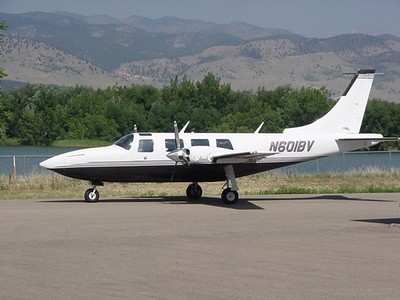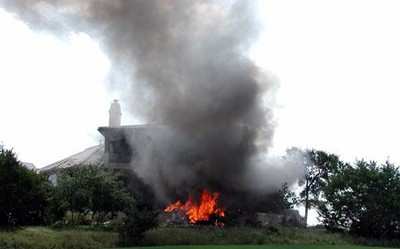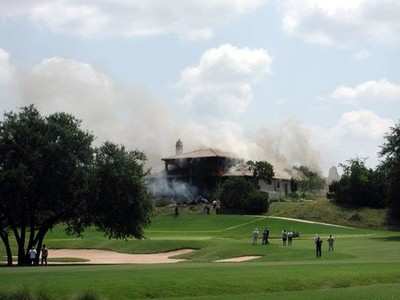May Also Have Been Overloaded
From the NTSB:
On August 3, 2004, at 1159 central daylight time, an Aerostar
PA-60-601P twin-engine airplane, N601BV, was destroyed shortly
after take off from Runway 16 (a 3,930- foot-long and 70-foot-wide
asphalt runway) at Lakeway Airpark (3R9), Austin, Texas. The
commercial pilot and five passengers (three adults and two
children) sustained fatal injuries. The airplane was registered to
and operated by Aviation Flight Standards, LLC, Wilmington,
Delaware. A visual flight rules (VFR) flight plan was filed for the
flight that departed Lakeway, about 1158, and was destined for
Wylie Post Airport (PWA), Oklahoma City, Oklahoma. Visual
meteorological conditions prevailed for the business flight
conducted under 14 Code of Federal Regulations Part 91.

A relative of four of the passengers onboard the airplane stated
that the pilot, a passenger and his brother-in-law landed at
Lakeway Airport about 1030. They had flown in to pick-up his
sister-in-law, niece and nephew, who had been visiting him for the
past week. Prior to departure, the relative observed the passenger
fuel the airplane and place "a lot" of luggage, including two car
seats and four overhead-sized pieces of luggage in the back of the
airplane. The pilot sat in the front left seat, the passenger sat
in the front right seat, his brother-in-law sat in the middle seat,
and his sister-in-law, niece and nephew sat in the aft seats. After
the airplane was loaded, both engines were started, and the
airplane taxied to the runway and started the take off roll. As the
airplane traveled down the runway, the relative got concerned
because it seemed to take "too long" to take off, and he thought
that the airplane should have become airborne a lot sooner. As the
airplane approached the end of the runway, it became airborne.
However, it did not climb and appeared to be "floating." It then
veered to the left, and "dove" quickly toward the ground.
A second witness arrived at Lakeway Airport about 1145 to pick
up her father who was flying in from Dallas, Texas. While she was
waiting, she purchased a soda from the soda machine, and saw a twin
engine airplane at the fuel pump. The witness noted two men, a
woman, and a toddler at the picnic table located near the soda
machine, and another man was fueling the airplane and loading the
luggage. One of the men at the picnic table said, "Well, we're
about ready to go." The witness grabbed her drink, and relocated to
a covered hangar located at the end of the parking lot. The witness
said she did not know how many people boarded the airplane, but did
notice "a lot" of luggage and a car seat being loaded into the
airplane. The airplane taxied to the end of the runway and did an
engine run-up. She said, "The plane then came down the runway, as
it passed, I was thinking the plane should be ready to lift-off and
that it sounded "awful quiet." It continued down the runway which
looked to be almost at the end of the runway. It did not seem to
have enough power to lift into the air. It just seemed to skim the
trees and make a left bank turn, it looked as if it just headed
straight down left wing and nose dive to the ground."
A third witness was also at Lakeway Airport and observed the
airplane's take off roll. He said that his first thought was that
the airplane should have been airborne a lot sooner, and his second
thought was that it was "too quiet." The airplane used up "every
bit of runway." As it became airborne, the airplane clipped the
trees at the far end of the runway and had trouble gaining altitude
and level flight. Shortly after, the airplane "tipped stalled" and
flew into the ground, followed by a loud explosion.

A fourth witness, a pilot, was in his home located near the
airport and was monitoring the airport's UNICOM frequency. He heard
the pilot announce the registration of the airplane, followed by
his intentions to depart Runway 16 at Lakeway Airport. Shortly
after, the witness heard the pilot abruptly say, "Oh God! I'm in
trouble...three with me..." The witness ran to his front yard, and
observed the airplane in a nose dive.
A fifth witness, a former flight instructor and twin-engine
rated pilot, was on a golf course adjacent to the accident site
when he heard an airplane approaching from the north. He looked up
and observed the airplane veering to the left in level flight about
500 feet above ground level (agl). He said it was yawing
back-and-forth, the wings were "dipping" up and down, and the
landing gear were retracted. The engines sounded as if they were at
full power. Then, the airplane made a steep left bank, rolled
inverted, and nose dived into the back porch of a home. The witness
said that when the airplane rolled inverted, it sounded as if both
engines were instantaneously "shut-off."
A sixth witness was also located on the golf course when he
heard the airplane. The witness described the engine noise as
"extreme" and it interrupted his golf putt. When he looked up the
airplane was banking to the left, almost inverted, as it descended
behind trees. The witness then saw black smoke and a fire
explosion. He said there was no noise from the engines just prior
to the explosion.
A seventh witness was working outside when he heard "a loud
engine of some kind suddenly stop." He looked up and saw a small
airplane flying low and then begin to nose dive towards the golf
course. A few moments later he heard an explosion.
An on-scene examination of the wreckage was conducted on August
3-4, 2004. All major components of the airplane were accounted for
at the site. The airplane impacted an approximately 5-foot-high
concrete retaining wall that supported the back patio of a private
residence. The post-impact fire consumed the airplane and the back
of the home sustained fire damage. The wreckage came to rest at an
elevation of approximately 900 feet mean sea level (msl), about 1.1
nautical miles from Lakeway Airport.

The pilot held a commercial pilot certificate for airplane
single-engine and multi-engine land, and instrument airplane. His
last Federal Aviation Administration (FAA) first class medical was
issued on June 1, 2004. At that time he reported a total of 3,500
flight hours.
Weather reported at Austin-Bergstrom International Airport
(AUS), Austin, Texas, about 16 nautical miles east of Lakeway
Airport, at 1153, was wind from 160 degrees at 3 knots, visibility
10 statute miles, scattered clouds at 3,500 feet and 15,000 feet,
temperature 90 degrees Fahrenheit, dew point 75 degrees Fahrenheit,
and a barometric pressure setting of 29.96 inches of Mercury. The
density altitude was approximately 3,000 feet msl.
 ANN's Daily Aero-Linx (04.13.24)
ANN's Daily Aero-Linx (04.13.24) ANN's Daily Aero-Term (04.13.24): Beyond Visual Line Of Sight (BVLOS)
ANN's Daily Aero-Term (04.13.24): Beyond Visual Line Of Sight (BVLOS) Airborne 04.09.24: SnF24!, Piper-DeltaHawk!, Fisher Update, Junkers
Airborne 04.09.24: SnF24!, Piper-DeltaHawk!, Fisher Update, Junkers Aero-News: Quote of the Day (04.14.24)
Aero-News: Quote of the Day (04.14.24) ANN's Daily Aero-Term (04.14.24): Maximum Authorized Altitude
ANN's Daily Aero-Term (04.14.24): Maximum Authorized Altitude





